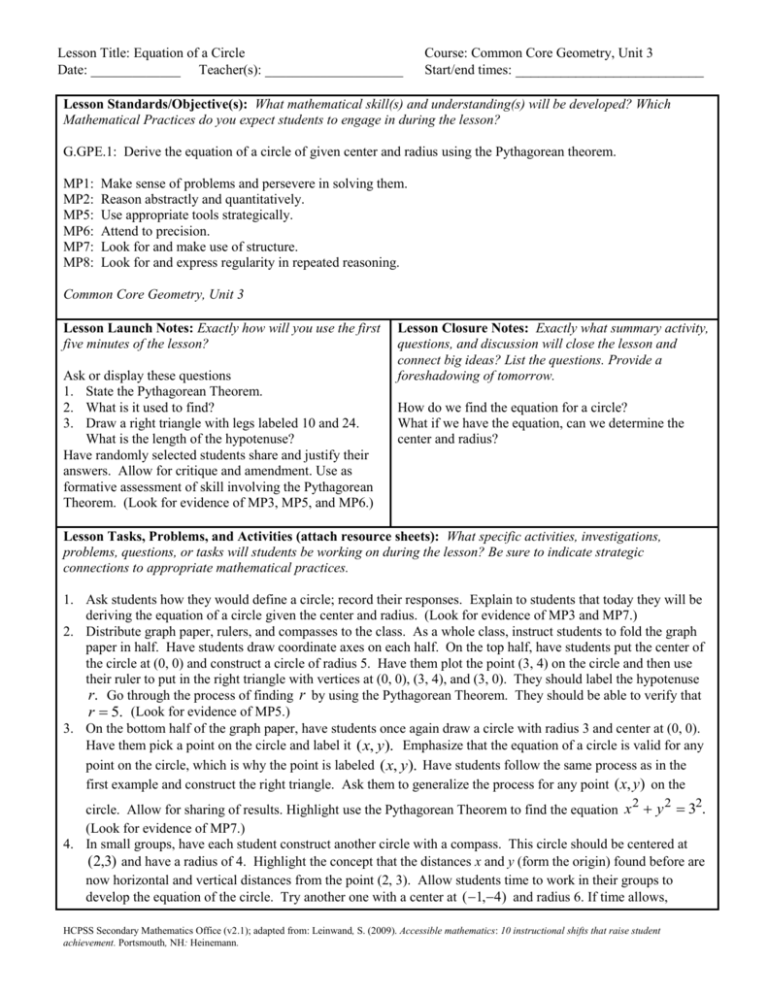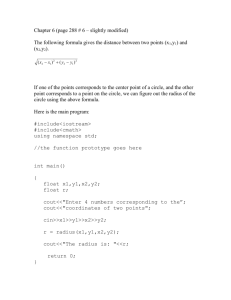G.GPE.A.1 Lesson Equation of a Circle
advertisement

Lesson Title: Equation of a Circle Date: _____________ Teacher(s): ____________________ Course: Common Core Geometry, Unit 3 Start/end times: _________________________ Lesson Standards/Objective(s): What mathematical skill(s) and understanding(s) will be developed? Which Mathematical Practices do you expect students to engage in during the lesson? G.GPE.1: Derive the equation of a circle of given center and radius using the Pythagorean theorem. MP1: MP2: MP5: MP6: MP7: MP8: Make sense of problems and persevere in solving them. Reason abstractly and quantitatively. Use appropriate tools strategically. Attend to precision. Look for and make use of structure. Look for and express regularity in repeated reasoning. Common Core Geometry, Unit 3 Lesson Launch Notes: Exactly how will you use the first five minutes of the lesson? Ask or display these questions 1. State the Pythagorean Theorem. 2. What is it used to find? 3. Draw a right triangle with legs labeled 10 and 24. What is the length of the hypotenuse? Have randomly selected students share and justify their answers. Allow for critique and amendment. Use as formative assessment of skill involving the Pythagorean Theorem. (Look for evidence of MP3, MP5, and MP6.) Lesson Closure Notes: Exactly what summary activity, questions, and discussion will close the lesson and connect big ideas? List the questions. Provide a foreshadowing of tomorrow. How do we find the equation for a circle? What if we have the equation, can we determine the center and radius? Lesson Tasks, Problems, and Activities (attach resource sheets): What specific activities, investigations, problems, questions, or tasks will students be working on during the lesson? Be sure to indicate strategic connections to appropriate mathematical practices. 1. Ask students how they would define a circle; record their responses. Explain to students that today they will be deriving the equation of a circle given the center and radius. (Look for evidence of MP3 and MP7.) 2. Distribute graph paper, rulers, and compasses to the class. As a whole class, instruct students to fold the graph paper in half. Have students draw coordinate axes on each half. On the top half, have students put the center of the circle at (0, 0) and construct a circle of radius 5. Have them plot the point (3, 4) on the circle and then use their ruler to put in the right triangle with vertices at (0, 0), (3, 4), and (3, 0). They should label the hypotenuse r. Go through the process of finding r by using the Pythagorean Theorem. They should be able to verify that r 5. (Look for evidence of MP5.) 3. On the bottom half of the graph paper, have students once again draw a circle with radius 3 and center at (0, 0). Have them pick a point on the circle and label it ( x, y). Emphasize that the equation of a circle is valid for any point on the circle, which is why the point is labeled ( x, y). Have students follow the same process as in the first example and construct the right triangle. Ask them to generalize the process for any point (x, y) on the circle. Allow for sharing of results. Highlight use the Pythagorean Theorem to find the equation x 2 y 2 32. (Look for evidence of MP7.) 4. In small groups, have each student construct another circle with a compass. This circle should be centered at ( 2,3) and have a radius of 4. Highlight the concept that the distances x and y (form the origin) found before are now horizontal and vertical distances from the point (2, 3). Allow students time to work in their groups to develop the equation of the circle. Try another one with a center at ( 1,4) and radius 6. If time allows, HCPSS Secondary Mathematics Office (v2.1); adapted from: Leinwand, S. (2009). Accessible mathematics: 10 instructional shifts that raise student achievement. Portsmouth, NH: Heinemann. Lesson Title: Equation of a Circle Course: Common Core Geometry, Unit 3 Date: _____________ Teacher(s): ____________________ Start/end times: _________________________ challenge them to find the equation of the circle if the center is named (h, k ) , the radius is r, for any point on the circle (x,y). As an alternative for students that are having difficulty using the compass and graph paper, students can use Geometer’s Sketchpad for their constructions and computations. As students are working, you may want to have the following websites available: http://www.brightstorm.com/math/trigonometry/pythagorean-theorem/equation-of-a-circle/ Students may watch the beginning of this presentation for a hint It offers visuals and guided steps of the concepts in this lesson. 5. Bring the class back together. Have groups share what they learned through their investigation. Have students generate the equation for a circle with center at (h, k ) and radius r . (Look for evidence of MP7 and MP8.) Evidence of Success: What exactly do I expect students to be able to do by the end of the lesson, and how will I measure student success? That is, deliberate consideration of what performances will convince you (and any outside observer) that your students have developed a deepened and conceptual understanding. Students will be able to determine the equation of any circle with a given center and radius. For example, have students write an equation for the circle with center at ( 2,3) with radius 4. Have them explain why there are 2 2 addition signs in the parentheses for ( x 2) ( y 3) 16 . Notes and Nuances: Vocabulary, connections, anticipated misconceptions (and how they will be addressed), etc. Students must be able to apply the Pythagorean Theorem correctly. Students may have difficulty drawing the triangle or determining the lengths of the legs once the circle is no longer centered at (0,0). Students may be confused about the signs if the center involves negative coordinates. Resources: What materials or resources are essential for students to successfully complete the lesson tasks or activities? Ruler Compass Computers with internet access Geometers Sketchpad http://www.brightstorm.com/math/trigonometry/pythagoreantheorem/equation-of-a-circle/ Homework: Exactly what follow-up homework tasks, problems, and/or exercises will be assigned upon the completion of the lesson? Teachers can choose from numerous problems in the textbook. Lesson Reflections: How do you know that you were effective? What questions, connected to the lesson standards/objectives and evidence of success, will you use to reflect on the effectiveness of this lesson? Were students able to determine the equation once the center was moved from the origin? How about when the center had negative (h, k ) values? Could students generalize their results to derive the equation for any circle having center at (h, k ) and radius r , without using the Pythagorean Theorem? Howard County Public Schools Office of Secondary Mathematics Curricular Projects has licensed this product under a Creative Commons Attribution-NonCommercial-NoDerivs 3.0 Unported License. HCPSS Secondary Mathematics Office (v2.1); adapted from: Leinwand, S. (2009). Accessible mathematics: 10 instructional shifts that raise student achievement. Portsmouth, NH: Heinemann.







